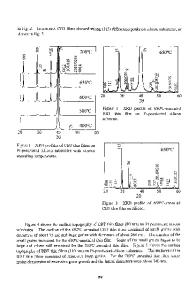Low Temperature Laser-Doping Process Using PSG and BSG Films for Poly-Si TFTs
- PDF / 168,325 Bytes
- 6 Pages / 612 x 792 pts (letter) Page_size
- 95 Downloads / 298 Views
Low Temperature Laser-Doping Process Using PSG and BSG Films for Poly-Si TFTs Cheon-Hong Kim, Sang-Hoon Jung, Jae-Hong Jeon and Min-Koo Han School of Electrical Engineering, Seoul National University, San 56-1 Shinlim-dong, Kwanak-gu, Seoul 151-742, Korea ABSTRACT A simple low-temperature excimer-laser doping process employing phosphosilicate glass (PSG) and borosilicate glass (BSG) films as dopant sources is proposed in order to form source and drain regions for polycrystalline silicon thin film transistors (poly-Si TFTs). We have successfully controlled sheet resistance and dopant depth profile of doped poly-Si films by varying PH3/SiH4 flow ratio, laser energy density and the number of laser pulses. The penetration depth and the surface concentration of dopants were increased with increasing laser energy density and the number of laser pulses. The minimum sheet resistance of 450Ω/□ for phosphorus (P) doping and 1100Ω/□ for boron (B) doping were successfully obtained. Our experimental results show that the proposed laser-doping process is suitable for source/drain formation of poly-Si TFTs. INTRODUCTION Polycrystalline silicon thin film transistors (poly-Si TFTs) employing the excimer laser annealing have attracted a considerable attention for high quality active matrix liquid crystal displays (AMLCDs) [1]. Although excimer laser annealing ensures high-quality poly-Si films, but the low-temperature doping method for source and drain regions is not well established yet. The ion implantation and the ion shower doping method require high-cost complex equipments and the post-annealing is also required in order to activate the dopants and to cure implant damages. The excimer-laser doping using doping gas sources or dopant-containing films is a useful method because it is a simple and low-temperature doping process [2-5]. In such processes, excimer laser irradiation melts an a-Si layer and results in liquid-phase incorporation of dopants. In case of laser-doping using doping gas, sophisticated gas chamber and control system are required [4,5]. Furthermore, it is difficult to accurately control the sheet resistance and junction depth because dopants are supplied mainly from the absorbed layers formed either prior to the laser irradiation or during the irradiation [5]. The purpose of our work is to report a simple low-temperature laser-doping method Q8.4.1
employing phosphosilicate glass (PSG) and borosilicate glass (BSG) films as dopant sources. PSG and BSG films have been deposited by chemical vapor deposition (CVD) method, which is compatible to a conventional poly-Si TFTs process, easy to achieve uniformity and reproducible. We have controlled sheet resistance and depth profile of doped poly-Si films by varying PH3/SiH4 flow ratio, as well as laser energy density and the number of laser pulses. Sheet resistance was measured and dopant depth profile was investigated by spreading resistance profiling (SRP) and Hall measurement. EXPERIMENTS AND RESULTS A 100nm-thick hydrogenated amorphous silicon (a-Si:H) film was depos
Data Loading...









